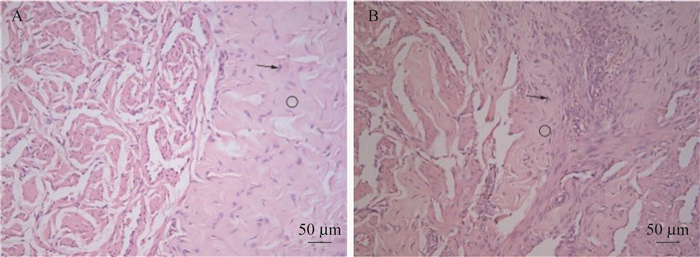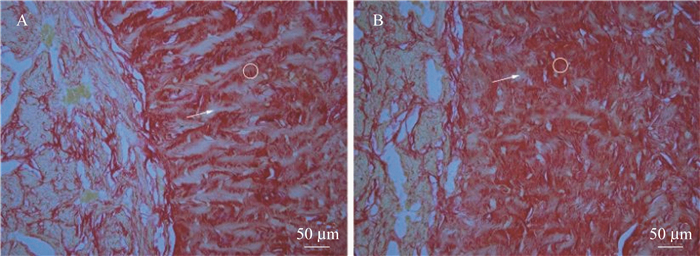阴茎海绵体纤维化是阴茎组织的常见及多发病变,高脂血症、糖尿病和高血压等多种疾病均可导致阴茎海绵体纤维化[1-3],因此,准确评估阴茎海绵体的纤维化程度具有重要临床意义。目前,临床只能通过组织活检技术检测相关病理学指标来定量评估阴茎海绵体的纤维化程度。组织活检属有创性检查,可引起阴茎血肿、硬结和疼痛等并发症,存在影响勃起功能的风险[4];同时,作为外生殖器,阴茎组织活检等有创检查的临床应用前景十分受限,亟需探索适用于临床定量评估阴茎海绵体纤维化程度的无创方法。剪切波弹性成像(shear wave elastography,SWE)是一项刚刚应用于临床定量分析阴茎组织病变的超声新技术。初步研究发现,SWE可定量评估阴茎海绵体的硬度、鉴别动脉性勃起功能障碍和非动脉性勃起功能障碍以及诊断阴茎硬结症[5-8];同时,利用SWE进行肝纤维化定量评估的临床价值已获得国内外学者的共识[9-10]。目前,鲜见有关SWE能否准确定量评价阴茎海绵体的纤维化程度的研究报道,故本研究试图通过动物实验探索利用SWE定量评价新西兰白兔阴茎海绵体纤维化程度的可行性。
材料和方法主要试剂 3%戊巴比妥钠、PBS缓冲液、TBS缓冲液(国药集团上海化学试剂有限公司);重组人转换生长因子β1(transforming growth factor beta 1,TGF-β1)(100-21-10,美国Pepro Tech公司);无水乙醇、二甲苯、苏木精染液、伊红染液、Scott蓝化液、柠檬酸钠缓冲液、DAB试剂盒(上海迈新生物技术有限公司);抗纤维连接蛋白(fibronectin,FN)抗体、抗Ⅲ型胶原纤维(collagen type Ⅲ,Col Ⅲ)抗体(NBP1-51723和NBP1-5119SS,美国Novus公司)。
检查仪器 Aixplorer超声诊断仪、SL 15-4探头(美国HOLOGIC公司),组织脱水机(湖北亚光医用技术电子有限公司),病理切片机、石蜡包埋机(德国Leica公司),光学显微镜(日本Olympus公司)。
实验动物 本研究随机选取不同周龄阴茎海绵体正常的雄性新西兰白兔和阴茎海绵体发生纤维化的雄性新西兰白兔各10只(由复旦大学附属浦东医院实验动物中心提供),阴茎海绵体发生纤维化的新西兰白兔为通过向阴茎海绵体组织内注射重组人TGF-β1构建(一次性注射13~17 μg,20天后)。实验操作符合复旦大学附属浦东医院伦理委员会对动物实验伦理的要求(实验课题伦理编号:YJRCJJ-201804)。
SWE检查 使用3%戊巴比妥钠(1.0 mL/kg)耳缘静脉注射麻醉,兔麻醉后,取仰卧位固定于加热垫上。消毒阴茎及四周皮肤,选取阴茎横切面进行SWE检查;灰阶图像清晰显示阴茎组织后,开启SWE模式,图像优化调节设置为“Pen”,焦点深度为2 cm,增益为30%;阴茎组织SWE图像稳定显示5 s后,连续存图30 s;回放图像,选取质量合格的图像测量阴茎海绵体的剪切波弹性量化测值(shear wave elastic quantitative measurement,SWQ)。质量合格的图像标准为阴茎海绵体白膜及内部组织色彩充填完整且无马赛克样干扰斑点,SWQ测量感兴趣区为最大程度包绕白膜外缘的圆形感兴趣区,测量单位选择kPa。所有兔的阴茎SWE检查均由同一名从事SWE检查工作5年以上的高年资超声医师在双盲的情况下完成。
组织学分析 SWE检查完成后,即刻处死兔,并切取阴茎组织,制备厚度为3 μm的石蜡切片。
苏木精-伊红(HE)染色 石蜡切片经HE染色后,在光镜下(×200)观察阴茎海绵体组织内成纤维细胞及胶原纤维(collagen fiber,CF)的分布。
苦味酸-天狼星红染色 石蜡切片经饱和苦味酸液-苏木精液染色后,在光镜下(×200)观察,随机选取阴茎海绵体组织内的5个视野,使用Image J软件分析并测量CF和平滑肌细胞(smooth muscle cell,SMC)的阳性面积占阴茎海绵体总面积的百分比,计算CF/SMC比值。
免疫组织化学染色 石蜡切片脱蜡及水化,PBS缓冲液浸泡,98 ℃柠檬酸钠缓冲液中恒温抗原修复30 min;0.3%过氧化氢溶液清除内源性过氧化物酶;含10%马血清及1%牛血清白蛋白的TBS缓冲液室温下孵育1 h,以封闭非特异性抗原;滴加经TBS缓冲液稀释的一抗溶液(1∶50稀释的抗FN抗体、1∶100稀释的抗Col Ⅲ抗体),于湿盒中4 ℃过夜孵育;滴加含1%牛血清白蛋白的TBS缓冲液稀释的二抗,室温孵育2 h;DAB显色,苏木精复染细胞核3 min,冲洗、分化、脱水和透明后封片。光镜下(×200)观察切片,随机选取阴茎海绵体组织内的5个视野,使用Image J软件分别计算FN和Col Ⅲ的阳性区域占阴茎海绵体总面积的百分比。组织切面图像分析由病理学专业技术人员完成。
统计学方法 使用SPSS 26.0软件进行统计学分析。定量资料用x±s表示。对定量资料(周龄、体质量和SWQ)进行正态性检验和方差齐性检验,符合正态分布且方差齐的资料采用两独立样本t检验进行比较,不符合正态分布和(或)方差不齐的资料则采用曼-惠特尼秩和检验进行比较。选用Spearman秩相关检验对兔阴茎海绵体的SWQ与CF/SMC、FN和Col Ⅲ进行相关性分析。双侧P < 0.05为差异有统计学意义。
结果一般资料 10只阴茎海绵体正常的新西兰白兔周龄为16~24周,体质量为2.10~3.00 kg,10只阴茎海绵体发生纤维化的新西兰白兔周龄为17~23周,体质量为2.20~2.85 kg(表 1);两组间周龄和体质量差异无统计学意义(表 2)。
| Number | Rabbits with normal penile cavernosa | Rabbits with penile cavernosa fibrosis | |||||
| Age(wk) | Body weight(kg) | SWQ(kPa) | Age(wk) | Body weight(kg) | SWQ(kPa) | ||
| 1 | 24 | 3.00 | 10.7 | 21 | 2.61 | 21.1 | |
| 2 | 22 | 2.73 | 10.4 | 22 | 2.70 | 21.6 | |
| 3 | 23 | 2.82 | 9.8 | 22 | 2.72 | 23.8 | |
| 4 | 21 | 2.60 | 10.0 | 23 | 2.85 | 21.4 | |
| 5 | 20 | 2.58 | 9.3 | 21 | 2.64 | 23.8 | |
| 6 | 18 | 2.30 | 9.0 | 19 | 2.44 | 23.4 | |
| 7 | 16 | 2.10 | 10.0 | 17 | 2.20 | 21.8 | |
| 8 | 17 | 2.20 | 9.9 | 18 | 2.30 | 22.2 | |
| 9 | 18 | 2.30 | 9.4 | 19 | 2.46 | 20.9 | |
| 10 | 20 | 2.51 | 9.1 | 19 | 2.42 | 21.8 | |
| SWQ:Shear wave elastic quantitative measurement. | |||||||
| (x±s) | |||||||||||||||||||||||||||||
| Item | Rabbits with normal penile cavernosa | Rabbits with penile cavernosa fibrosis | t or Z | P | |||||||||||||||||||||||||
| Age(wk) | 19.90±2.64 | 20.10±1.97 | 0.192 (1) | 0.850 | |||||||||||||||||||||||||
| Bodyweight(kg) | 2.51±0.29 | 2.53±0.20 | 0.179 (1) | 0.860 | |||||||||||||||||||||||||
| SWQ(kPa) | 9.76±0.56 | 22.18±1.09 | -3.784(2) | < 0.001 | |||||||||||||||||||||||||
| (1) t-test;(2) Wilcoxon rank-sum test. SWQ:Shear wave elastic quantitative measurement. | |||||||||||||||||||||||||||||
SWE检查 20只兔子均成功完成阴茎组织SWE检查,并获得合格的阴茎海绵体图像。经SWQ测量(图 1),SWQ为(15.97±6.43)kPa(表 1);两组间SWQ测值差异有统计学意义(P < 0.001,表 2)。

|
| SWE images of normal penile cavernosa (A) and fibrotic penile cavernosa (B) were both qualified. The tunica albuginea and its internal tissue (circle) were completely filled with color without mosaic-like points. Q-BoxTM: The measurement result of SWQ; Mean: The mean value of SWQ; SWE: Shear wave elastography; SWQ: Shear wave elastic quantitative measurement. 图 1 新西兰白兔阴茎海绵体的SWE图像 Fig 1 SWE images of penile cavernosa in New Zealand white rabbits |
组织学分析 HE染色(图 2)显示10只阴茎海绵体正常兔的阴茎海绵体均未发生纤维化,10只阴茎海绵体纤维化兔的阴茎海绵体均可见发生纤维化。苦味酸-天狼星红染色(图 3)测值:CF为54.50%±13.82%,SMC为35.31%±9.04%,CF/SMC的比值为1.78±1.10。免疫组化(图 4)测值:FN为22.09%±7.91%,Col Ⅲ为19.06%±11.13%。

|
| In normal penile cavernosa (A), the structure of tunica albuginea and cavernosa was regular, and the contents of collagen fibers (circle) and fibroblasts (arrow) were usual. While in the fibrotic penile cavernosa (B), the tunica albuginea and cavernosa were disordered, and the contents of collagen fibers (circle) and fibroblasts (arrow) were significantly increased. 图 2 新西兰白兔阴茎海绵体组织HE染色图像 Fig 2 HE staining of penile cavernosa in New Zealand white rabbits |

|
| Collagen fibers (circle) were stained red, and smooth muscle cells (arrow) were stained yellow in normal penile cavernosa (A) and fibrotic penile cavernosa (B). 图 3 新西兰白兔阴茎海绵体组织苦味酸-天狼星红染色 Fig 3 Sirius red staining of penile cavernosa in New Zealand white rabbits |

|
| The positive areas (arrows) of fibronectin (A, B) and collagen type Ⅲ (C, D) were stained brown in normal penile cavernosa (A, C) and fibrotic penile cavernosa (B, D). 图 4 新西兰白兔阴茎海绵体组织免疫组化染色图像 Fig 4 Immunohistochemical staining of penile cavernosa in New Zealand white rabbits |
相关性分析 由表 3可见,SWQ与CF/SMC、FN和Col Ⅲ均相关(P < 0.001),且呈高度正相关。
| Fibrotic indicators | SWQ | |
| Coefficient of association | P | |
| CF/SMC | 0.760 | < 0.001 |
| FN | 0.888 | < 0.001 |
| Col Ⅲ | 0.801 | < 0.001 |
| SWQ:Shear wave elastic quantitative measurement;CF:Collagen fiber;SMC:Smooth muscle cell;FN:Fibronectin;Col Ⅲ:Collagen type Ⅲ. | ||
本研究通过动物实验证明,利用SWE可以对新西兰白兔阴茎海绵体纤维化程度进行定量评价。这一研究成果对于阴茎海绵体纤维化诊断具有重要的临床意义。阴茎海绵体纤维化是一种累及阴茎海绵体白膜的结缔组织疾病,也是高脂血症、糖尿病等多种疾病的主要并发症之一[11]。作为一种慢性进展性病变,阴茎海绵体纤维化早期常无明显的临床症状,病变进展会引起纤维条索、硬结、弯曲和缩短,并伴有阴茎疼痛症状,同时导致勃起功能障碍的发生[12]。因此,准确及时评价阴茎海绵体纤维化至关重要[13]。
阴茎海绵体纤维化的主要病理生理过程为:多种病因导致阴茎海绵体内出现炎症反应,炎性细胞积聚、氧自由基生成并释放一系列纤维源性因子(如TGF-β1)[14];TGF-β1对炎症细胞(巨噬细胞、中性粒细胞)和成纤维细胞具有趋化作用,能促进成纤维细胞增殖并转化为肌成纤维细胞,导致过量胶原蛋白沉积,CF增生[2];FN是TGF-β1诱导阴茎海绵体纤维化过程中的重要靶蛋白,可以刺激成纤维细胞增殖并分泌大量细胞外基质(如Col Ⅲ)[15-17];细胞外基质的增加会影响SMC的生长,导致SMC萎缩和凋亡、CF与SMC的比例失衡,进一步加重阴茎海绵体的纤维化程度,进而影响勃起功能[18]。根据上述病理过程可知,阴茎海绵体组织内CF/SMC比值越大、FN和Col Ⅲ的含量越多,阴茎海绵体的纤维化程度越重。据此,国内外学者认为[2, 19-20]利用CF/SMC、FN和Col Ⅲ可以定量评价阴茎海绵体组织的纤维化程度。
CF/SMC、FN和Col Ⅲ的测定需要通过活检获取组织进行免疫组化等分析。由于组织活检为侵入性有创检查,通常可以导致阴茎血肿、纤维化和疼痛等并发症,这些并发症存在影响勃起功能的风险;同时,该器官的特殊性使得患者接受有创检查的意愿更低,任何有创检查都无法作为常规检查方法应用于阴茎海绵体,因此探索无创评价阴茎海绵体纤维化程度的临床检查方法具有重要的意义。
SWE是一项可定量评价组织病变的新型超声检查技术,组织内成分及其含量发生变化会引起SWQ测值改变,当组织发生不同程度纤维化时,SWQ测值会同时发生相应的变化[21]。同时,国内外研究已证实,SWE可以准确进行肝脏、肾脏和肌肉等组织纤维化程度的定量评价[9, 22-24]。据此推测:阴茎海绵体的SWQ也可以作为评价阴茎海绵体纤维化程度的一项定量指标。我们通过获取不同周龄阴茎海绵体正常和阴茎海绵体发生纤维化的新西兰白兔(周龄、体质量均无差异),利用SWE测量所有兔阴茎海绵体的SWQ;在完成SWQ测量后,立即获取阴茎海绵体组织进行CF/SMC、FN和Col Ⅲ的定量测量,并分析SWQ与CF/SMC、FN和Col Ⅲ的相关性。结果显示,SWQ与CF/SMC、FN和Col Ⅲ分别呈高度正相关。
本研究尚存在以下不足之处:用于评价阴茎海绵体纤维化程度的病理学指标仅包括CF/SMC、FN和Col Ⅲ,而评价阴茎海绵体纤维化程度的病理学指标还包括羟脯氨酸含量、Ⅰ/Ⅲ型胶原比值、α-平滑肌肌动蛋白阳性面积/海绵体总面积百分比等。
CF/SMC、FN和Col Ⅲ是反映阴茎海绵体纤维化程度的客观指标,本研究结果提示:SWQ是一项新的反映阴茎海绵体纤维化程度的定量指标,SWE可作为一项定量评价阴茎海绵体纤维化程度的无创新技术,值得深入研究。
作者贡献声明 饶宛婷,张雪莹 实验操作,数据采集,论文撰写和修订。申宜昊,陶秀红 实验操作,数据采集。邢晋放 课题设计,实验操作和指导,数据分析,论文构思和修订。
利益冲突声明 所有作者均声明不存在利益冲突。
| [1] |
STURNY M, ANGUENOT L, COSTA-FRAGA FP, et al. Apelin-13 protects corpus cavernosum against fibrosis induced by high-fat diet in an MMP-dependent mechanism[J]. J Sex Med, 2021, 18(5): 875-888.
[DOI]
|
| [2] |
QABAZARD B, YOUSIF M, MOUSA A, et al. GYY4137 attenuates functional impairment of corpus cavernosum and reduces fibrosis in rats with STZ-induced diabetes by inhibiting the TGF-β1/Smad/CTGF pathway[J]. Biomed Pharmacother, 2021, 138(11): 111486.
|
| [3] |
KIM J, DRURY R, MORENAS R, et al. Pathophysiology and grayscale ultrasonography of penile corporal fibrosis[J]. Sex Med Rev, 2021, 10(1): 99-107.
|
| [4] |
BAŞAR M, SARGON M, BAŞAR H, et al. Electron microscopic findings of penile tissues in veno-occlusive dysfunction: is penile biopsy necessary?[J]. Int Urol Nephrol, 1998, 30(3): 331-338.
[DOI]
|
| [5] |
ZHANG J, QIAO X, GAO F, et al. A new method of measuring the stiffness of corpus cavernosum penis with ShearWave™ Elastography[J]. Br J Radiol, 2015, 88(1048): 20140671.
[DOI]
|
| [6] |
ZHOU W, ZHANG Y, LI L, et al. Evaluation of arterial erectile dysfunction using shear wave elastography: a feasibility study[J]. J Ultrasound Med, 2021, 40(6): 1209-1216.
[DOI]
|
| [7] |
RICHARDS G, GOLDENBERG E, PEK H, et al. Penile sonoelastography for the localization of a non-palpable, non-sonographically visualized lesion in a patient with penile curvature from Peyronie's disease[J]. J Sex Med, 2014, 11(2): 516-520.
[DOI]
|
| [8] |
AYBAR MD, TURNA O. Assessment of the rigidity changes of corpus cavernosum penis in vasculary erectile dysfunction (ED) subtypes by shear wave elastography (SWE)[J]. J Ultrasound Med, 2022, 41(3): 629-636.
[DOI]
|
| [9] |
RONOT M, FERRAIOLI G, MÜLLER H, et al. Comparison of liver stiffness measurements by a 2D-shear wave technique and transient elastography: results from a European prospective multi-centre study[J]. Eur Radiol, 2021, 31(3): 1578-1587.
[DOI]
|
| [10] |
梁萍, 郑荣琴. 二维剪切波弹性成像评估慢性乙型肝炎肝纤维化临床应用指南[J]. 临床肝胆病杂志, 2018, 34(2): 255-261. [DOI]
|
| [11] |
MILENKOVIC U, ALBERSEN M, CASTIGLIONE F. The mechanisms and potential of stem cell therapy for penile fibrosis[J]. Nat Rev Urol, 2019, 16(2): 79-97.
[DOI]
|
| [12] |
EGYDIO PH. An innovative strategy for non-grafting penile enlargement: a novel paradigm for tunica expansion procedures[J]. J Sex Med, 2020, 17(10): 2093-2103.
[DOI]
|
| [13] |
WINTER A, RUBIN R, GOLDSTEIN I. Improving diagnostic capture of organic ED on ultrasound: corporal heterogeneity grading to assess penile fibrosis[J]. J Sex Med, 2018, 15(2): S82.
|
| [14] |
SWISLOCKI A, EISENBERG M. Peyronie's disease as a marker of inflammation -is there hope on the horizon?[J]. Am J Med, 2021, 134(10): 1218-1223.
[DOI]
|
| [15] |
WAN ZH, LI GH, GUO YL, et al. Amelioration of cavernosal fibrosis and erectile function by lysyl oxidase inhibition in a rat model of cavernous nerve injury[J]. J Sex Med, 2018, 15(3): 304-313.
[DOI]
|
| [16] |
HU F, YU Y, LU F, et al. Knockdown of transient receptor potential melastatin 2 reduces renal fibrosis and inflammation by blocking transforming growth factor-β1-activated JNK1 activation in diabetic mice[J]. Aging, 2021, 13(22): 24605-24620.
[DOI]
|
| [17] |
HIDAYAT M, PRAHASTUTI S, YUSUF M, et al. Nutrition profile and potency of RGD motif in protein hydrolysate of green peas as an antifibrosis in chronic kidney disease[J]. Iran J Basic Med Sci, 2021, 24(6): 734-743.
|
| [18] |
ZHANG J, LI S, ZHANG S, et al. Effect of icariside Ⅱ and metformin on penile erectile function, histological structure, mitochondrial autophagy, glucose-lipid metabolism, angiotensin Ⅱ and sex hormone in type 2 diabetic rats with erectile dysfunction[J]. Sex Med, 2020, 8(2): 168-177.
[DOI]
|
| [19] |
YIN Y, PENG J, ZHOU J, et al. Tetrathiomolybdate partially alleviates erectile dysfunction of type 1 diabetic rats through affecting ceruloplasmin/eNOS and inhibiting corporal fibrosis and systemic inflammation[J]. Sex Med, 2021, 10(1): 100455.
|
| [20] |
CHO MC, LEE J, PARK J, et al. Restoration of cavernous veno-occlusive function through chronic administration of a jun-amino terminal kinase inhibitor and a LIM-kinase 2 inhibitor by suppressing cavernous apoptosis and fibrosis in a rat model of cavernous nerve injury: a comparison with a phosphodiesterase type 5 inhibitor[J]. World J Mens Health, 2021, 39(3): 541-549.
[DOI]
|
| [21] |
WANG B, GUO Q, WANG J, et al. Ultrasound elastography for the evaluation of lymph nodes[J]. Front Oncol, 2021, 11: 714660.
[DOI]
|
| [22] |
OZTURK A, OLSON MC, SAMIR AE, et al. Liver fibrosis assessment: MR and US elastography[J]. Abdom Radiol (NY), 2022, 47(9): 3037-3050.
|
| [23] |
CHHAJER G, ARUNACHALAM VK, RAMASAMY R, et al. Elastography: a surrogate marker of renal allograft fibrosis-quantification by shear-wave technique[J]. Pol J Radiol, 2021, 86(1): ; e151-e156.
[DOI]
|
| [24] |
MARTINS-BACH AB, BACHASSON D, ARAUJO ECA, et al. Non-invasive assessment of skeletal muscle fibrosis in mice using nuclear magnetic resonance imaging and ultrasound shear wave elastography[J]. Sci Rep, 2021, 11(1): 284.
[DOI]
|
 2022, Vol. 49
2022, Vol. 49


